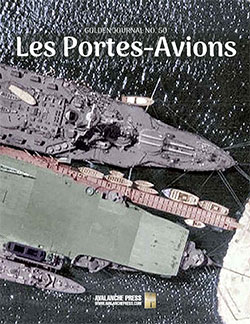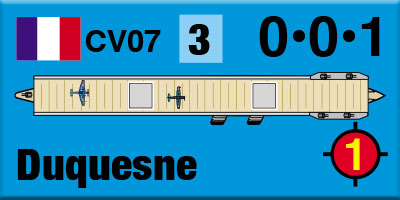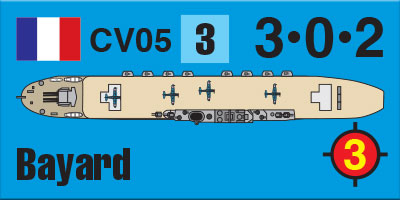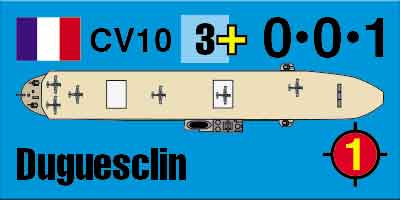| Golden Journal No. 50:
Les Portes-Avions
French Carrier Projects
by Mike Bennighof, Ph.D.
February 2024
 Despite the failure of the aircraft carrier Béarn, France’s Marine Nationale recognized that the type could be a great addition to the Force de Raid, the flotilla of modern warships intended to counter German surface raiders in case of a renewed war in which France stood alone without British support. Despite the failure of the aircraft carrier Béarn, France’s Marine Nationale recognized that the type could be a great addition to the Force de Raid, the flotilla of modern warships intended to counter German surface raiders in case of a renewed war in which France stood alone without British support.
The heavy cruisers Duquesne and Tourville had likewise been failures as warships; lacking the protection to stand up to anything carrying an armament heavier than a rifle, and the speed to escape the ships carrying dangerous weapons. With the pair of cruisers obviously unable to fight the new and well-armored Italian heavy cruisers, the Marine Nationale began studies in the 1930’s to convert them to aircraft carriers.
The Service Technique des Constructions Navale (STCN), which designed French warships, produced four variants of a carrier conversion. Two designs kept the foremost 203mm gun turret, with one having a slightly longer flight deck and hangar than the other. Another design shifted the hangar/flight deck combination forward and kept the aft-most gun turret. And the final design did away with all of the heavy guns, with a hangar and flight deck taking up the entire hull. All of the variants would carry six twin mounts for the new 100mm Model 1935 heavy anti-aircraft gun, plus light weapons. Displacement would rise from 10,000 to about 12,000 tons; enough to count against France’s treaty allotment.

The fine lines of the cruisers would make for a very long and narrow hangar, leaving them with an air group of 12 to 14 planes for the full-length variant, and presumably even less for the cruiser-carrier hybrids. That made the expense of the conversions seem a poor investment, and the project would be abandoned in favor of new carriers designed as such from the keel up. The Marine Nationale, seeing the value of aircraft carriers once war broke out, looked into reviving the project in the spring of 1940, but nothing came of the initiative.
The 1922 Washington naval limitations agreement allotted France 60,000 tons’ worth of aircraft carriers. Béarn took up 22,000 tons, leaving 38,000 tons for new construction. Despite her crapulence, Béarn could not be replaced until 1948, twenty years after her completion. Even if she were scrapped well before then, as she deserved, she still counted against the allotment (unless she suffered an accident, which given her condition was not unlikely).
This explains why many of the designs had displacements of 19,000 tons (allowing two carriers to be built) or just under 13,000 (allowing for three such ships). But not all of them; some of the design studies apparently took place with no regard for the treaty’s limits (or reflected a belief that its terms would expire before the ship would be built).
The STCN began work on new carriers in 1929, with PA1 (“Aircraft Carrier Number One”), a big ship at 27,400 tons carrying eight 203mm guns (the maximum allowed under the treaty) plus a dozen 100mm heavy anti-aircraft guns in six twin mounts. Her flight deck, at least as initially designed, would not have reached either bow or stern; a twin turret for her 203mm guns would be placed on the main deck, below each “corner” of the flight deck. Each end of the flight deck would have a catapult, and she would have a large port-side island much like that of Béarn. A variant design, PA2, did away with the island and came in slightly larger at 28,500 tons. Both ships would operate about 54 aircraft. Like Béarn’s initial design, these carriers would also operate floatplanes.
As an alternative, STCN offered PA3, a ship of 13,500 tons’ displacement operating 24 aircraft. She would not operate floatplanes, and only have anti-aircraft weapons, without the 203mm guns of the bigger carriers. But France could build three of them on her allowable tonnage, and the design became the basis for multiple larger variants. PA4 scaled up the ship to 18,000 tons, so that two of them could be built, and each would operate 38 aircraft.

The next carrier, PA5, was offered in two variants. PA5a was an enlarged PA4, capable of flying off fighters directly from its hangar deck by way of a special, short launching platform over the bow; the STCN designers appear to have lifted this idea from the British carrier Glorious. That feature was already becoming obsolete, as newer aircraft required a longer roll-off in order to get airborne than the short flying-off deck could provide. She displaced 24,500 tons, and had a designed capacity of 48 aircraft.
PA5b kept the same hull, but deleted the flying-off deck and moved the hangar/flight deck structure forward to clear the quarterdeck, where a quadruple turret for 330mm guns (apparently the same Model 1932 turret with Model 1931 guns that armed the battle cruiser Dunkerque) would be sited. That level of armament would grossly violate the Washington accords.
Note: Two examples of aircraft carrier PA5b appear in Golden Journal No. 50: Les Portes-Avions as the Bayard class. While these were the least likely of the offered designs to be built, they’re also the most interesting.
With design PA6, the STCN reverted to the cruiser-carrier hybrid concept, this time with two triple turrets for 203mm Model 1924 guns. At this point the Marine Nationale had no triple mount for the 203mm guns, though one would be sketched eventually for the projected St. Louis-class heavy cruisers. The carrier would operate 28 aircraft.
The sketches and particulars for the next several submissions (PA7 through PA9) appear not to have survived; PA10 went back to the light carrier of 14,000 tons with a speed of 33 knots allowing it to operate with the Force de Raid. She would be a flush-decked ship without an island, and an air group of 28 planes. PA11 took the displacement up to 15,350 tons, using the extra weight for more powerful machinery and a speed of 34 knots; PA12 added an armored belt and deck of unspecified thickness, at a cost of a displacement of 17,300 tons.

Design PA13 took a radically different approach, proposing a fleet carrier centered on its air group (much like concurrent Japanese and American design theory), and displacing 19,000 tons. She would have a full-length flight deck, a starboard island and would carry 70 aircraft. Design PA14 extended the hangar slightly, to allow an air group of 76 planes.
Note: Aircraft carrier PA14 also appears in Golden Journal No. 50: Les Portes-Avions, with two examples of the Foudre class. While this design would be declined, it’s the most powerful of the proposed carriers.
Another variant of the design increased displacement to 23,000 tons, offering more protection and slightly less speed; this PA15 design would operate the same air group as PA14. At 250 meters in length, she would have been larger than the British Ark Royal and American Yorktown classes, and not quite as large as the U.S. Navy’s Essex class.
The next design, PA16, would be accepted as the Joffre class.
The Golden Journal is only available to the Gold Club (that’s why we call it the Golden Journal).
Click here to join the Gold Club.
See your Gold Club Insider newsletter for ordering information.
Sign up for our newsletter right here. Your info will never be sold or transferred; we'll just use it to update you on new games and new offers.
Mike Bennighof is president of Avalanche Press and holds a doctorate in history from Emory University. A Fulbright Scholar and NASA Journalist in Space finalist, he has published a great many books, games and articles on historical subjects; people are saying that some of them are actually good.
He lives in Birmingham, Alabama with his wife, three children, and new puppy. He misses his lizard-hunting Iron Dog, Leopold.
Want to keep Daily Content free of third-party ads? You can send us some love (and cash) through this link right here.
|
